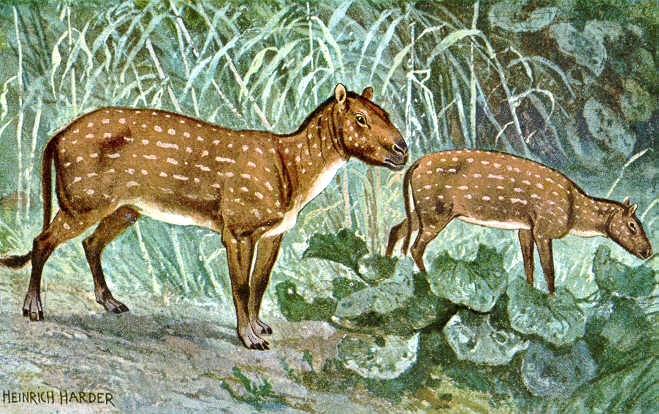 |
 |
 |
 |
 |
Produced
by the Population Genetics and Evolution class, Furman University |
||||
 |
 |
 |
 |
 |
Produced
by the Population Genetics and Evolution class, Furman University |
||||
 |
The
Paleogene: Hyracotherium |
 |
||
| Hyracotherium
was a small, dog-sized animal that is sometimes called “dawn horse”
because it is one of the precursors to modern horse evolution. They were
approximately two feet in length and 8 to 14 inches at the shoulder, weighing
on average about 50 pounds (Wikipedia 2010). Hyracotherium were
thought to be browsers which lived in forests. They had four toes on their
front feet and three toes plus two vestigial toes on their rear feet (Olson
2006). Each toe had a pad at the bottom (Wikipedia 2010). They also had
short faces with eye sockets at the middle, and the space in between the
front and teeth cheeks, the diastema, was short (Florid Museum of Natural
History 2010). The first fossil was found by Richard Owen, who named it
Hyracotherium upon seeing its similarities to modern hyrax. Later,
it was found that his specimen was the same as North American specimens
that had been named Eohippus, so although the name was changed
to Hyracotherium, they are sometimes referred to as Eohippus
(Wikipedia 2010). Hyracotherium used to be classified as a member
of the Equidae, but has been reclassified as a palaeothere, a family related
to both horses and brontotheres (Wikipedia 2010). Hyracotherium
is thought to be ancestral to horse’s other perissodactyl relatives
including rhinoceros and tapirs (Florida Museum of Natural History 2010).
Page by Laura Snyder |
 |
| Hyracotherium. Photo From: Wikipedia | |
|
Olson R. 2006. Evidence of Horse Evolution. Saint Joseph’s College. Accessed April 13, 2010. Florida Museum of Natural History. 2010. Hyracotherium. Accessed April 13, 2010. Wikipedia. 2010. Hyracotherium. Accessed April 13, 2010. |